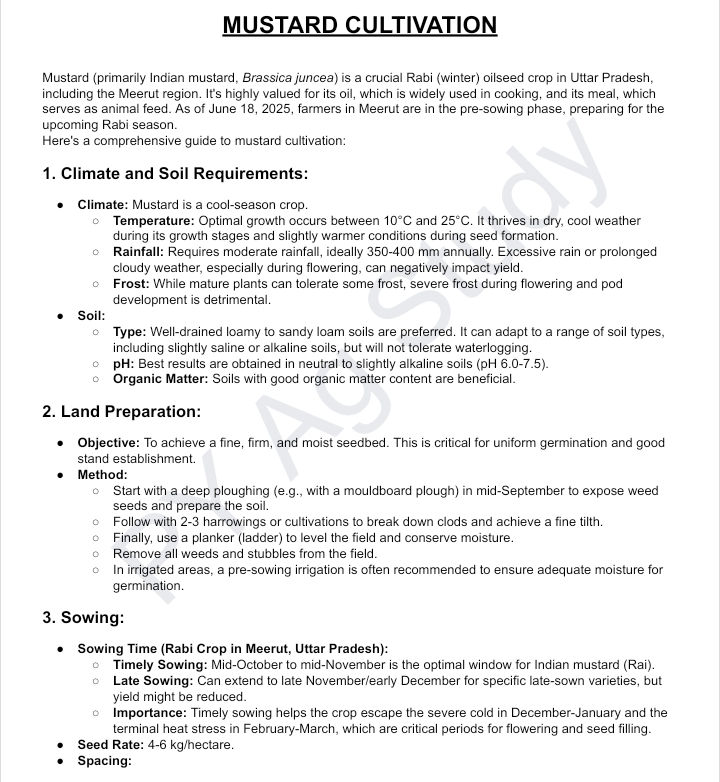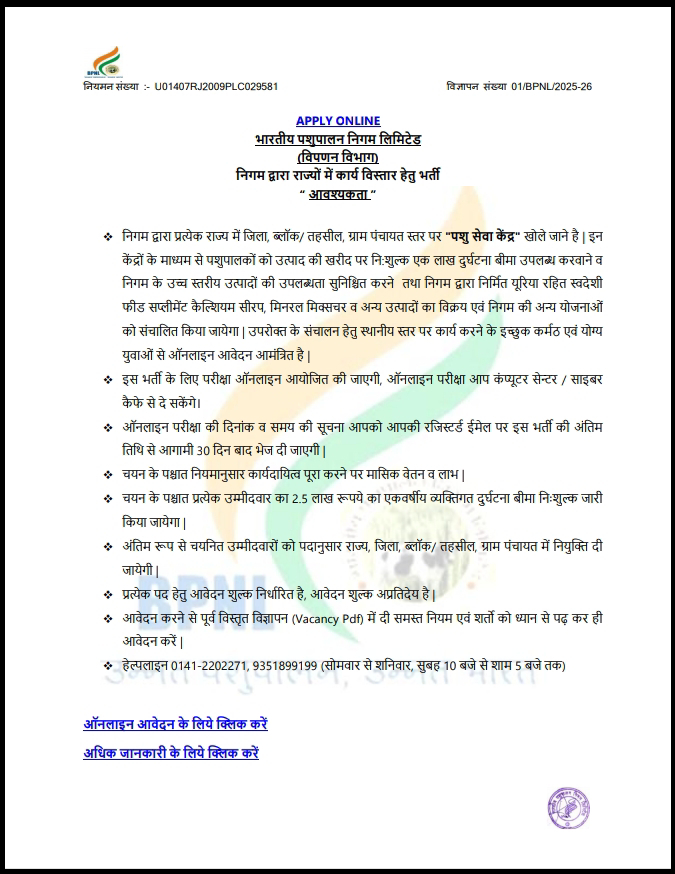Mustard (primarily Indian mustard, Brassica juncea) is a crucial Rabi (winter) oilseed crop in Uttar Pradesh, including the Meerut region. It's highly valued for its oil, which is widely used in cooking, and its meal, which serves as animal feed. As of June 18, 2025, farmers in Meerut are in the pre-sowing phase, preparing for the upcoming Rabi season.
Here's a comprehensive guide to mustard cultivation:
1. Climate and Soil Requirements:
Climate: Mustard is a cool-season crop.
Temperature: Optimal growth occurs between 10°C and 25°C. It thrives in dry, cool weather during its growth stages and slightly warmer conditions during seed formation.
Rainfall: Requires moderate rainfall, ideally 350-400 mm annually. Excessive rain or prolonged cloudy weather, especially during flowering, can negatively impact yield.
Frost: While mature plants can tolerate some frost, severe frost during flowering and pod development is detrimental.
Soil:
Type: Well-drained loamy to sandy loam soils are preferred. It can adapt to a range of soil types, including slightly saline or alkaline soils, but will not tolerate waterlogging.
pH: Best results are obtained in neutral to slightly alkaline soils (pH 6.0-7.5).
Organic Matter: Soils with good organic matter content are beneficial.
2. Land Preparation:
Objective: To achieve a fine, firm, and moist seedbed. This is critical for uniform germination and good stand establishment.
Method:
Start with a deep ploughing (e.g., with a mouldboard plough) in mid-September to expose weed seeds and prepare the soil.
Follow with 2-3 harrowings or cultivations to break down clods and achieve a fine tilth.
Finally, use a planker (ladder) to level the field and conserve moisture.
Remove all weeds and stubbles from the field.
In irrigated areas, a pre-sowing irrigation is often recommended to ensure adequate moisture for germination.
3. Sowing:
Sowing Time (Rabi Crop in Meerut, Uttar Pradesh):
Timely Sowing: Mid-October to mid-November is the optimal window for Indian mustard (Rai).
Late Sowing: Can extend to late November/early December for specific late-sown varieties, but yield might be reduced.
Importance: Timely sowing helps the crop escape the severe cold in December-January and the terminal heat stress in February-March, which are critical periods for flowering and seed filling.
Seed Rate: 4-6 kg/hectare.
Spacing:
Row to Row: 45-60 cm (for Indian mustard).
Plant to Plant: 10-15 cm.
Sowing Depth: 2-3 cm. Shallow sowing ensures good germination.
Method: Use a seed drill for uniform sowing and precise depth placement.
4. Varieties (Suitable for Uttar Pradesh):
Choosing the right variety is crucial for yield and disease resistance. Some popular and suitable varieties for Uttar Pradesh include:
Pusa Bold: High yielding, good oil content, relatively tolerant to diseases.
Pusa Vijay (NPJ-93): Good for timely sowing, high oil content.
Pusa Mustard 25 (NPJ-112): Suitable for early sown irrigated conditions, high temperature tolerance at juvenile stage.
Pusa Mustard 26 (NPJ-113): Suitable for late sown irrigated conditions.
Pusa Mustard 27 (EJ-17): Suitable for early sown irrigated conditions & for multiple cropping.
RH 0406, RH 749: High yielding, good oil content.
DRMRIJ 31 (Giriraj): Good yield potential.
DMH 1 (Dhara Mustard Hybrid): Popular hybrid with good yield potential.
SMH20-22: Hybrid tolerant to frost and diseases, good oil content.
SVJ-314: Research variety best suited for soils of UP, MP, Gujarat & Rajasthan.
Always consult with local agricultural extension services for the latest recommendations on varieties best suited for your specific area within Meerut, considering soil type and local conditions.
5. Seed Treatment:
Treat seeds with a broad-spectrum fungicide like Thiram or Captan (2.5 g/kg seed) to protect against seed-borne diseases and improve seedling vigor.
For areas prone to white rust, Apron 35SD (6 g/kg seed) can be effective.
6. Nutrient Management (Fertilization):
Mustard is a heavy feeder and responds well to balanced nutrition, especially nitrogen and sulfur.
General Recommendations (per hectare):
Nitrogen (N): 80-120 kg (for irrigated conditions). For rainfed, 60-80 kg N.
Phosphorus (P2O5): 40-60 kg.
Potassium (K2O): 20-40 kg.
Sulfur (S): 20-40 kg. Sulfur is vital for oil synthesis and protein formation. Use fertilizers like Single Super Phosphate (SSP), Gypsum, or Ammonium Sulphate.
Zinc (Zn) & Boron (B): Micronutrients can be crucial, especially in deficient soils. Apply based on soil test reports.
Application:
Basal Dose (at sowing): Half of the nitrogen, and all phosphorus, potassium, and sulfur should be applied before or at the time of sowing.
Top Dressing (with first irrigation): The remaining half of nitrogen should be applied around 30-45 days after sowing.
7. Irrigation Management:
Mustard is sensitive to water stress at critical growth stages.
Number of Irrigations: Typically 2 irrigations are critical for good yield.
Critical Stages:
Pre-flowering / Rosette to Branching stage: Around 35-45 days after sowing. This irrigation supports vegetative growth and prepares for flowering.
Pod Formation / Siliqua filling stage: Around 65-80 days after sowing. This is crucial for seed development and oil accumulation.
Considerations:
If irrigation water is scarce, prioritize the pre-flowering stage.
Avoid waterlogging at all stages, as it can damage the crop.
Avoid irrigation between December 25 and January 15, as this period is generally very cold and can increase the risk of Sclerotinia rot.
8. Weed Control:
Weeds compete significantly with mustard, especially during the early growth stages.
Manual Weeding: 1-2 hand weedings at 15-20 days and 35-40 days after sowing are highly effective. Thinning should also be done to maintain optimal plant spacing.
Herbicides:
Pre-emergence: Pendimethalin (1 kg a.i./ha) applied within 1-2 days of sowing.
Post-emergence: Consult local agricultural authorities for recommendations on specific post-emergence herbicides for broadleaf and grassy weeds in your area.
9. Pest Management:
Major Pests:
Mustard Aphid (Lipaphis erysimi): The most devastating pest. They suck sap, causing leaf curling, stunted growth, and honeydew secretion leading to sooty mold.
Painted Bug (Bagrada hilaris): Damages young seedlings and pods.
Mustard Sawfly (Athalia lugens proxima): Larvae feed on leaves, especially at the seedling stage.
Diamondback Moth (Plutella xylostella): Larvae feed on leaves, creating holes.
Management Strategies (Integrated Pest Management - IPM):
Timely sowing: Often helps escape peak aphid incidence.
Resistant varieties: Choose varieties known for pest tolerance.
Biological control: Encourage natural enemies like ladybird beetles and lacewings.
Mechanical control: Collection and destruction of infested plant parts in early stages.
Chemical control: Use recommended insecticides (e.g., Imidacloprid, Thiamethoxam, or neem-based formulations) only when pest populations reach economic threshold levels.
10. Disease Management:
Major Diseases:
Alternaria Blight (Alternaria brassicae): Causes dark brown, concentric spots on leaves, stems, and pods, leading to defoliation and yield loss.
White Rust (Albugo candida): Appears as white, raised pustules on leaves, stems, and inflorescence. Can cause distortion and "staghead" symptoms.
Downy Mildew (Hyaloperonospora parasitica): Yellowish patches on upper leaf surface with a white, fuzzy growth on the underside. Often occurs in complex with white rust.
Sclerotinia Stem Rot (Sclerotinia sclerotiorum): Causes wilting, rotting of stems, and internal black sclerotia (survival structures).
Powdery Mildew (Erysiphe cruciferarum): White, powdery growth on leaves, stems, and pods.
Management Strategies:
Resistant varieties: Utilize available disease-resistant varieties.
Crop Rotation: Essential, especially for soil-borne diseases like Sclerotinia. Avoid continuous cultivation of Brassica crops.
Seed Treatment: As mentioned, with fungicides.
Field Sanitation: Remove and destroy infected plant debris after harvest.
Fungicide Sprays: Apply recommended fungicides (e.g., Mancozeb for Alternaria; Metalaxyl for white rust/downy mildew; Sulphur for powdery mildew) at early stages or as a preventive measure based on disease pressure.
11. Harvesting:
Maturity Indicators:
70-80% of the pods turn yellowish.
Seeds in the pods become firm and mature.
The crop starts to dry down.
Timing: Harvest when pods are still slightly moist (e.g., in the morning) to minimize shattering losses.
Method:
Manual: Cut plants close to the ground with a sickle. Stack them in bundles in the field for 5-7 days for sun-drying.
Mechanical: Combine harvesters can be used for large areas.
Threshing: Once sufficiently dry (seed moisture content 15-20%), threshing can be done manually, by treading with bullocks, or using power threshers.
Cleaning and Drying: Clean the threshed seeds thoroughly. Sun-dry them to about 8% moisture content before storage.
Storage: Store in clean, dry, airtight bags or bins to prevent insect infestation and moisture absorption.
By adhering to these comprehensive practices, farmers in Meerut can optimize their mustard yield and profitability.

.jpeg)






